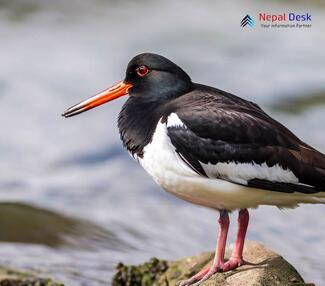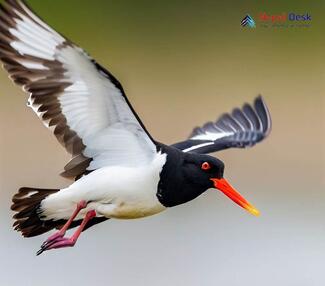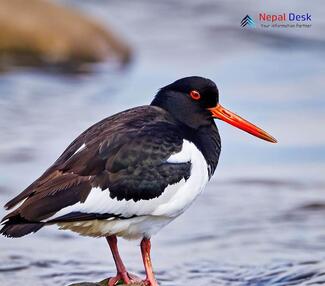The charismatic Eurasian Oystercatcher easily distinguishes itself among the world’s many shorebird species thanks to its unmistakable long, orange-red bill and bold eye-catching plumage. Typically sporting a black head contrasting with surrounding white, their long legs and stout stance accommodate prying open tightly sealed shellfish from coastal mudflats in western Europe, with outlying populations spanning scattered habitats along coastlines into China and Southeast Asia.
While rare, the Eurasian Oystercatcher has also appeared occasionally as a vagrant visitor along Nepal's interior tributaries far detached from its Pacific breeding habitats. The availability of shallow gradually flowing waters mimicking conditions nearer sea level drainage seems to attract individual birds temporarily during seasonal migrations across Asia. These scattered sightings along the Trishuli and Narayani Rivers hint at fascinating questions about what long wayward journey landed these striking estuary-dwelling birds so far inland in a mountainous country.
Taxonomy and Physical Description
The Eurasian Oystercatcher (Haematopus ostralegus) belongs to the Haematopodidae family of sturdy shorebirds adapted to prying open shellfish. Its genus name Hematopus derives from the Greek meaning “blood foot”, referring to its bright red bill and legs. The species name ostralegus means “oyster catcher” in Latin, denoting its specialized diet of bivalves like mussels and cockles.
A large and vocal shorebird, Eurasian Oystercatchers average 40-46 cm long with a stark black head and upper breast cleanly transitioning into pure white undersides and belly. Their plumage appears solid black from afar, offset by those signature crimson bills and pinkish-red legs. Males and females look nearly identical with females averaging slightly larger. Juveniles hatch with gray-brown plumage instead of black which slowly molts to maturity by year 2.
When seen in flight, Eurasian Oystercatchers reveal a broad white stripe along their open black wings flashing brightly, allowing easier identification. On the ground, they stride in an upright posture accented by their prominent bill used as a hammer to pry open shellfish or stab them for extraction, exhibiting a highly specialized tool for accessing their main food sources along coastal intertidal zones.
Distribution and Habitat
The Eurasian Oystercatcher occupies coastal habitats along marine shorelines spanning across Iceland, coastal Western Europe, Scandinavia, and northern portions of Asia down into China and Southeast Asia where tidal mudflats provide access to beds of shellfish like oysters, mussels, and clams. They prefer sandy or rocky beaches and estuaries rather than shingle beaches for nesting and foraging.
As Eurasian Oystercatchers strongly associate with saltwater ecosystems during breeding, migration, and wintering, they remain conspicuously absent from interior continental locations far from the ocean.
Yet oddly, rare sightings of individual vagrant Eurasian Oystercatchers have been documented even within landlocked Nepal, one of the most inland countries on Earth. While reasons remain speculative, the theory suggests some migratory birds become disoriented while traversing eastern Asia and descend along major river valleys within Nepal that potentially mimic deltas in appearance while furnishing gradual shore-like banks supporting limited food supply as the lost birds rest and attempt to orient back to coastal zones. These accidental occurrences underscore fascinating questions about aberrant migration pathways over the Himalayas.
Feeding Behavior and Diet
The Eurasian Oystercatcher has specially adapted feeding habits to gain access to nutrient-rich marine mollusks and shellfish. Employing their long, robust beaks like can openers and tweezers, oystercatchers pry open the tightly sealed shells of bivalves like mussels, oysters, and cockles. They then swiftly cut the muscle to claim the meat using scissor-like motions of their laterally flattened bill tip.
Supplementing shellfish, oystercatchers feed opportunistically on a range of other coastal creatures including shrimp, crabs, snails, marine worms, and sometimes fish depending on local prey availability along rocky or muddy shorelines. Their diet varies seasonally and geographically across food niches they occupy in coastal Europe and Asia.
When appearing aberrantly inland such as along major rivers in Nepal, Eurasian Oystercatchers likely adapt their feeding strategy taking insects, fish, and crustaceans where available instead of marine shellfish. Potentially the mud banks of meandering lowland rivers furnish enough probing opportunities that the birds can utilize their inherent feeding behaviors, supporting them with available substitute dietary items to resolve the navigation mishap.
Breeding and Life Cycle
Eurasian Oystercatchers nest in scrapes along gravel or sandy coastal areas starting around May each spring. The nests typically contain 2-3 speckled, elongated eggs in clumps of scattered nesting colonies. Incubation responsibility splits between both male and female oystercatchers lasting about 27-29 days.
Soon after hatching, gangly gray-brown oystercatcher chicks feed independently commencing an entirely carnivorous mollusk diet. Their distinctive red-orange bills have been present since birth. Chicks fledge breeding grounds at around 35 days old. Juvenile plumage matures over 2 years towards adult black upperparts and white underside appearance.
Given this ecology is strictly linked to raising young along cold-water marine coasts, any oystercatchers accidentally finding themselves far inland such as in Nepal during migration periods would not likely attempt to nest or breed. At best solitary migrants may pause temporarily before hopefully resuming orientation back towards habitual habitat. Their appearance remains an aberration highlighting the extreme distances covered by migratory shorebirds susceptible to periodic displacement tracing obscure Asian flyways over the high Himalayas.
Migration Patterns
Eurasian Oystercatchers undertake seasonal migrations using established routes along western Eurasian coasts that reduce their presence at higher latitude summer nesting grounds while boosting overwintering numbers along southern Europe and Asian shorelines. Satellite tracking reveals elliptical loops spanning over 3000 km for roundtrip travel.
While most follow shore-hugging paths, some data points to the existence of alternative longer overland routes tracing indirect inland courses before reaching destination zones. Reasons could involve shorter water crossings through river valleys or avoidance of certain mountain barriers constraining coastal terrain.
It is hypothesized that the rare occurrence of vagrant Eurasian Oystercatchers within the interior of Nepal relates to these alternative inland migration trajectories going awry on occasion. The theory suggests inclement weather or navigation errors send some portion of migrants descending into major Himalayan foothills river basins within Nepal, mistaking these increasingly southern landscapes for approaching the coast.
Thereby accidental Eurasian Oystercatcher sightings in Nepal are likely traced to errant overland migration detours made by a periodically misplaced minority veering off course into the high mountain valleys before correcting back towards coastal environs. The phenomena spotlight the amazing distances covered by shorebirds that sometimes falter even with strong homing instincts.
Human Interactions and Impact
Several anthropogenic factors threaten oystercatcher populations across their native coastal breeding habitats. Expanding shoreline development, dredging activity, and industrial pollution degrade the intertidal zones favored for foraging. Disturbance by ships or recreationists also harms nesting success. Trampling by unleashed dogs poses an acute danger to camouflaged ground nests.
Some data suggests oystercatchers avoid drained marshes converted to farmland. Changing sea levels and conditions due to climate shifts remain complex to predict but also endanger populations if warming Arctic summers allow tree encroachment diminishing tundra breeding grounds. Hunting further depleted historic numbers.
As inland vagrant occurrences in Nepal are likely traced to temporarily disoriented migrants making navigation errors, direct threats remain less in these atypical areas beyond difficulty finding food. However, pollution accumulating along rivers could pose toxicity if birds ingest contaminated prey during pitstops. Overall though, inland oystercatchers represent outliers detached from primary threats facing marine populations along densely populated Asian coasts undergoing rapid 21st-century development. Any conservation concern should prioritize those fragile frontline habitats where oystercatchers concentrate in the highest numbers.
Role of Citizen Science in Monitoring
While professional ornithological surveys furnish essential data, citizen science networks have proven enormously effective pools for collecting observations of unusual bird sightings that inform migration timing, species range dynamics, and niche occupancy details at ever larger scales. Platforms like eBird and iNaturalist aggregate worldwide user submissions of bird species occurrence, allowing modelers to pinpoint distribution patterns and integrate isolated records that previously evaded detection.
The documentation of scarce vagrant Eurasian Oystercatchers recorded occasionally within inland Nepal powerfully demonstrates the value of public participation in revealing obscure phenomena. Without widely distributed observers documenting their local landscapes, the presence of these uncommon coastal birds appearing aberrantly along certain Nepalese rivers may remain virtually unknown to science. Yet thanks to just a few serendipitous sightings self-reported through responsible citizen networks, a fascinating perspective emerges suggesting the immense scope of shorebird migrations that sometimes overflow expected boundaries.
As exemplified by lost oystercatchers, rare events often furnish disproportional ecological insights. Therefore cultivating expanded community enthusiasm toward bird monitoring and metadata contribution should stand as a high priority for illuminating obscure knowledge gaps across Asian migration corridors, empowering conservation policy, and enriching human connections to avian heritage.
Conservation Implications in Nepal
The aberrant occurrence of Eurasian Oystercatchers along Nepal's rivers spotlights the immense distances crossed by migratory birds that depend on networked habitats across continents. It underscores the threats these shorebirds face from coastal development and that environmental governance holds universal duties.
While unable to intervene for these disoriented vagrants, Nepal shoulders responsibility for general waterway health assisting local and migrant species alike. Oystercatchers indicate connectivity across ecosystems linked by migratory wildlife reliant on intact habitat chains. Breakdown anywhere impacts total population resilience.
Nepal’s role as a mountain gateway for threatened Asian avifauna heightens its conservation mandate beyond political borders. Stewarding clean tributaries and wetlands enables safe passage for myriad birds over the high Himalayas. Thereby the unexpected oystercatchers serve as anchor reminders that localized efforts compound globally through environmental cooperation across flyways.
Even aberrant sightings furnish opportunities to illuminate obscure ecological knowledge and reaffirm the shared commitment to sustaining vital habitats wherever possible. The surprising lost Oystercatchers spotlight that collective conservation truly works locally and globally simultaneously.
Global Conservation Efforts
Classified as a species of Least Concern by the IUCN Red List, Eurasian Oystercatcher numbers remain substantial with over 500,000 birds in Europe and decently stable population trends, though some eastern Asian breeding groups face higher threats from coastal development.
Across Western Europe, conservation measures aim to safeguard vulnerable beach and salt marsh habitats crucial for nesting and chick-rearing security. Predator control initiatives also look to deter mammals from raiding ground nests. Public access restrictions, boardwalk establishment, and dog leashing campaigns further protect sensitive zones hosting oystercatchers during breeding season.
In Asia, habitat protections similarly target coastline preservation along China's Yellow Sea where large proportions of the continental population are concentrated. South Korea and Southeast Asian countries are also encouraged to monitor the exploitation of intertidal flats and mangrove ecosystems, which furnish winter shelter.
As for Nepal, conservation groups advise maintaining healthy riverways and clean tributaries that could sporadically host navigating oystercatchers. Although rare, their sightings trigger global considerations. Thereby localized wetlands stewardship furnishes international dividends by assisting oystercatchers - and by extension shared migratory species - to traverse extreme inland shortcuts along these crucial Asian flyways.
Advancing Ornithological Research
The unexpected appearance of coastal species like the Eurasian Oystercatcher far inland in countries like Nepal furnishes unique ornithological research opportunities to track unusual migration routes and climate pressures on Asian birds.
Documenting timing, locations, and habitat conditions involving vagrant birds allows scientists to model probable navigation scenarios prompting aberrations. Comparing weather patterns may reveal climate variables spurring navigation mistakes. Data illuminates the enormity of migrations crossing continents while showcasing species’ adaptability to settling temporarily in unfamiliar environments.
Overview analyses can trace flyway hotspots most liable to force detoured trips. Field surveys should sample rivers to estimate food availability supporting off-track migrants grounded within unfamiliar Nepal valleys. Frequent monitoring increases the probability of detecting additional rare species appearing errantly beyond typical distributions.
Ultimately the puzzling phenomenon highlights remaining mysteries around bird migrations across Asia’s extreme terrain. However, methodical data collection fueled by curious sightings enables incremental steps toward decoding enigmatic occurrences. Thereby ornithologists rely greatly on public sighting contributions to incorporate unique observations advancing collective comprehension of just how unexpectedly dynamic seemingly routine migration events may transpire.
Every documented rarity holds the potential to unlock paradigm shifts regarding ecology and seasonal bird movements answering climate change. Even one lost oystercatcher in Nepal could steer understanding.
Conclusion
The charismatic Eurasian Oystercatcher stands out through both its stunning red-and-black plumage and supreme mastery as a coastal forager prying open stubborn shellfish across northern hemisphere shorelines. Its specialized marine niche adapts this avian shorebird uniquely to intertidal abundance from the UK through Kamchatka, relying on preserved breeding and wintering mud flats.
Yet what furnishes acute fascination are the exceptionally rare vagrant sightings of individual wayward Eurasian Oystercatchers occasionally documented even within the interior of the Tibetan plateau surrounded nation of Nepal - about as radically opposite an environment from saline beaches as imaginably possible on Earth. These aberrant occurrences showcase the immensity of trackless migration paths crossing Asia that occasionally overflow or miss intended stopovers. The mind boggles picturing what cosmic navigation miscalculation landed such an out-of-place species within the icy inner Himalayan drainages.
But more pragmatically, such odd incidents spotlight threats all migratory shorebirds face from climate disruptions and coastal habitat erosion that promise to heighten pressures on fragile long-distance species like the Eurasian Oystercatchers into the future across accelerating anthropogenic landscapes. Thereby even imponderably lost inland vagrants serve to underline intensifying vulnerability across Asia’s threaded migratory avian communities, prompting trans-continental collective conservation responsibility.




